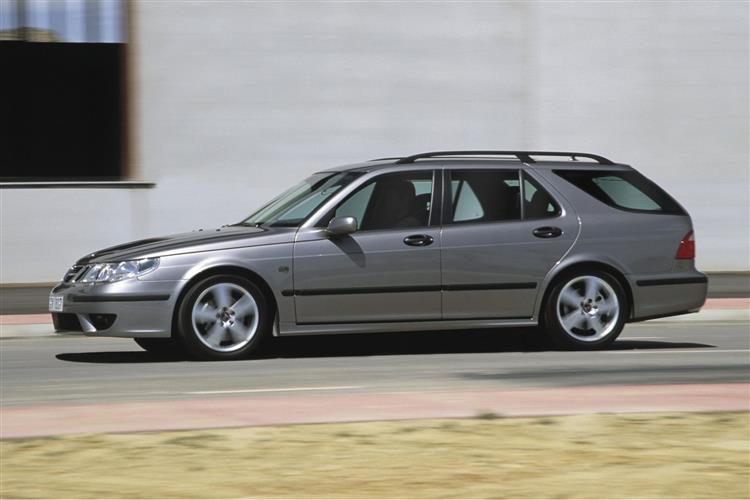SWEDISH REAL ESTATE (some text hidden) --NONE--
BY ANDY ENRIGHT
Introductionword count: 84
Saab enjoy making great play of their aerospace heritage but if you're worried about being charged for excess baggage, there's one car in their line up that will definitely offer Club Class comfort with a virtual bucket shop price tag - a used Saab 9-5 Estate. Well up to long haul business, this executive flyer is one that you'll be glad to give clearance to land on your driveway. Here's how to get your frequent flyer miles ticking over nicely in Saab's wide body.
Modelsword count: 27
Models Covered: 5 dr estate [2.0t, 2.0t SE, 2.3t, 2.3t SE, 3.0 V6t, 3.0 V6t SE, 3.0V6t Griffin, Aero, Airflow, Arc, Vector, Vector Sport, Linear, Linear Sport]
Historyword count: 406
The Saab 9-5 Estate debuted in October 1998 and was an instant hit with business users looking for something smart but not too sensible. Developments to the line up came thick and fast. In 1999 a more sporting option was launched, the Aero. This was a 2.3-litre car fitted with an aggressive bodykit, and suspension modifications designed to handle all 230bhp the 'HOT' designated engine now developed. Saab had turned back the clock to old-school 'big bang' turbocharging with some panache. The mean look was well received and the Saab 9-5 'Airflow' range of cars was introduced in January 2000, giving the four cylinder cars a more sporting appearance. These cars lasted until that Autumn when Saab introduced a series of range upgrades and added a more powerful 185bhp 2.3-litre petrol engine to sit above the existing 150bhp 2.0-litre unit. The range received a facelift in summer 2001, with a different grille, bigger bumpers and some interior tweaks. The Aero's engine was boosted to 250bhp and a 3.0-litre diesel model, the TiD, was announced alongside a 2.2-litre diesel unit purloined from the 9-3 range. The 3.0-litre V6 petrol engine was ditched in autumn 2003 to make way for a more powerful, more economical, less expensive and less dirty 2.3T powerplant boasting a hefty 220bhp wallop. The 9-5 line-up was improved significantly for the 2004 model year, with the introduction on 5-speed automatic variants of Saab's Sentronic gear selection featuring a gearchange via steering wheel mounted buttons. Electrically powered door mirrors were adopted from the 9-3 Sport Saloon and could be specified with an automatic folding function to make parking or manoeuvring in confined spaces that bit easier. This was available together with automatic dimming to eliminate dazzle. Inside the car, there were a few changes too, the most obvious of which were two revised fascia panels which could be specified in either dark grey walnut veneer or carbon fibre. Other options included ventilated sports seats and a state of the art DVD-based navigation system with a 7-inch colour touch screen LCD panel. The final tweak was the addition of two metallic paint finishes - Merlot Red and Graphite Green. Trim levels were also revised, the line up currently standing at Linear, Linear Sport, Vector, Vector Sport and HOT Aero. A further hefty facelift in the later stages of 2005 brought a sleeker look to the 9-5 front end. There were even bioethanol fuelled versions to consider.
What You Getword count: 287
Sit in a 9-5 Estate and it is still very much a Saab. Fears that the essentially quirky character of the Swedish manufacturer would be ironed out by General Motors have, thankfully, not materialised. You are still faced with a sheer wall of dashboard, the ignition key still slots home just ahead of the handbrake, and the bonnet is still of the original 'clam shell' style. The 'interesting' styling of Saab's not so distant past has mellowed, and the 9-5's is a far cry from the quirky 9000 shape. In terms of cabin space, you'll find a decent amount of elbow room and a decent 416-litre boot which grows to 890 litres with the rear seats folded. Thanks to the sloping rear tailgate, included to avoid the Volvo's boxy look, that's not quite as much as it's Swedish competitor. However, a range of clever design ideas more than compensate. Take the issue of strapping things down - a doddle in this case thanks to a couple of aircraft style aluminium cargo tracks concealed beneath plastic strips in the estate compartment. You simply clip a securing metal eye to one of these and, using spring-loaded straps, secure your load as necessary. For a little extra, you can also enjoy the benefit of a couple of even neater ideas. First, there's a sliding panel in the boot floor which glides out half a metre beyond the back of the car, either to make loading and unloading easier or simply (since it takes up to 200kg) to act as an impromptu picnic seat. Those with animals will also want to specify the sturdy metal divider which fits into the boot area to keep your furry friend separate from your luggage.
To see the full road test text contact us on 0330 0020 227
Pictures (high res disabled)

Scoring (subset of scores)
Category: Luxury Saloons and Estates
| Performance | |
| Handling | |
| Comfort | |
| Space | |
| Styling, Build, Value, Equipment, Depreciation, Handling, Insurance and Total scores are available with our full data feed. | |



